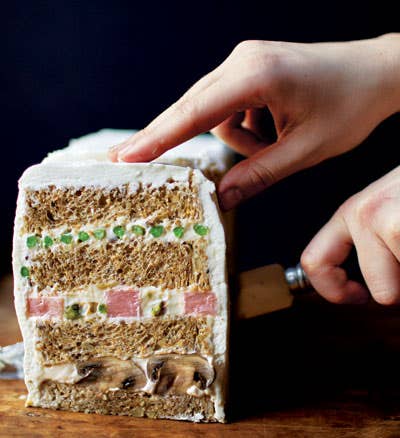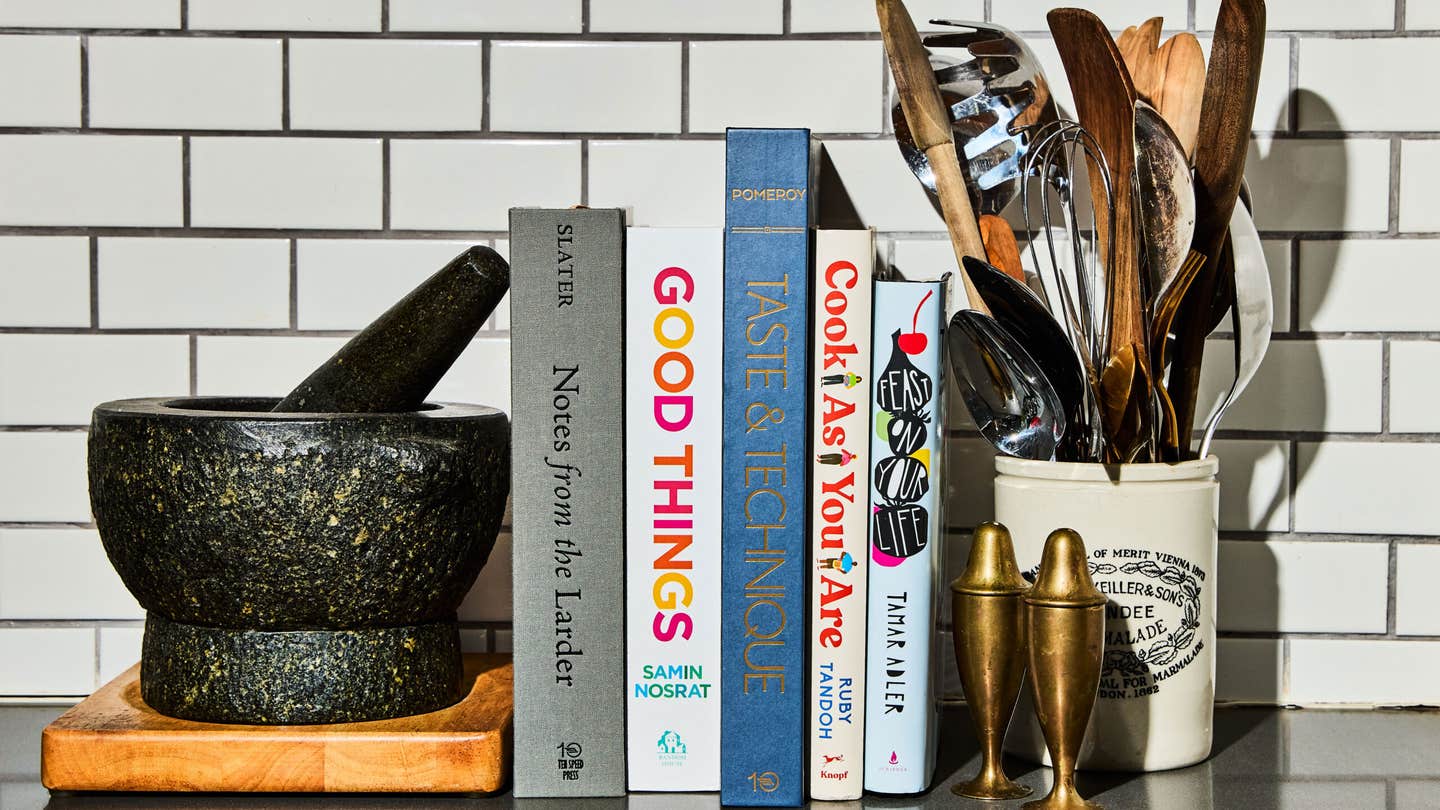
Edible Art: The History of American Sandwiches in Cookbooks
Sandwich recipes in cookbooks chronicle an American obsession
When I was a kid, I used to play with my mother's cookie cutters, and I was always intrigued by a tiny set she had, in the shape of clubs, spades, hearts, and diamonds. When she told me they were used for making fancy sandwiches, I wondered who would bother making sandwiches fancy. And why would anyone want them to be so small?
Years later, when I started collecting vintage cookbooks, I began to understand the logic of those tidbits. By my childhood, their time had already passed, but there in my mid-century cookbooks were the shape-cut sandwiches— canapes, really—laid out on a silver platter to be presented by a perfectly coiffed housewife to friends playing bridge. In an instant, I understood something about sandwiches I hadn't before: Because they are such an informal and intimate food (we eat them with our fingers, after all), they also represent an unguarded view of the moment's tastes, trends, and culinary ambitions. It dawned on me that many of the sandwiches I myself have been obsessed with at one time or another (the tarragon chicken salad on brioche; the buttery grilled Gruyere) were not only extensions of my personal craving, but emblems of the era's culinary zeitgeist.
So I decided to look back through sandwich recipes in cookbooks to see what they could tell me about how American tastes have evolved. I was surprised to find that, as much as we love sandwiches in this country, there isn't much written evidence of them before the 19th century. I imagine it's not because no sandwiches were consumed, but because sandwiches are one of the original convenience foods—two slices of bread, some meat, and voila! Why write about something so instinctive? Or perhaps it was because sandwiches had British connotations —it was the Earl of Sandwich who popularized them in the 18th century—that American authors weren't thrilled about honoring them. Regardless, it wasn't until 1837 that one of the first American recipes for sandwiches appeared in print, in Eliza Leslie's Directions for Cookery. It was for buttered bread, mustard, and thinly sliced ham—a sandwich I'd be happy to eat today (though I might not need the recipe).
One of the first cookbooks devoted to the sandwich was also one of the most interesting: Beverages and Sandwiches for Your Husband's Friends, by One Who Knows (G.L. Horton, 1893). The slim volume set forth that these meals were manly food, to be eaten with alcoholic punches or fine wine. And the recipes, which are adventurous even by today's standards, read like a trophy shelf of hard-won, exotic ingredients: Camembert sandwiches (with pear!), lamb sandwiches with capers, and even sandwiches made with "Botargo"_ [sic]_, the salty dried tuna roe.
At the dawn of the 20th century, there was indeed a manly air to many sandwiches: The great American hamburger, hot dog, and hero traditions were establishing themselves in the streets, but they were passed over on the printed page. These gutsy foods were not the kind favored by the reform-minded cooking experts of the day, like Sara Tyson Rorer and Fannie Farmer, who offered up the sandwich as a "dainty" food for "light entertaining." As cities got bigger and faster and louder, the bourgeois home was presented as a quiet haven from those forces. Home economists were preaching the value of modest cooking, thrift, and nutrition—effectively a kind of culinary temperance movement. In her 1894 cookbook Sandwiches, Rorer even tried to gentrify the workingman's lunch, proposing a double-decker sandwich, made with both wheat and white bread and spread with seasoned cottage cheese. "These are palatable, and are very much better for the average workman than bread and ham," she speculated.
But sandwiches are, by nature, fun. Eventually, recipes loosened up and encouraged homemakers to riff on the form. In the 1920s, when people could easily get their hands on tight-grained, soft-crumbed commercial sandwich bread, cookbooks and brochures published by bread and flour companies offered instructions for making whimsical party sandwiches, like the ones my mother's cookie cutters were used for. The fillings were mostly convenience foods, like tinned fruits, meats, and vegetables, mixed with store-bought mayonnaise or cream cheese to form sweet and savory spreads. There were sandwich rolls, sandwich checkerboards, and sandwich loaves—whole bread loaves sliced longitudinally and spread with different fillings, then cut into colorful cross-sections. I chuckled at the sheer ambition of one recipe in Wonder bread's 1930 pamphlet Wonder Sandwich Suggestions by Alice Adams Proctor: a five-layer Tower of Pisa Sandwich, which contained, from the top down: anchovies and olives, lobster, chicken, Hawaiian salad (pineapple, candied ginger, and lettuce), and for dessert, at the bottom, cream cheese and strawberries. Proctor does not, unfortunately, offer suggestions for how this sandwich is to be consumed.
Though I have yet to make a sandwich tower, I've sometimes fallen for this impulse toward sandwich cuteness—I've picked up a couple of bento sandwich cutters at my local Japanese market and tried to shape my kids' lunches into bunnies and stars. But inevitably, those cutters have moved to the back of my own drawers, just like my mother's so many years before.
So how did we get from yesteryear's party nibbles to the hearty, worldly sandwiches we love today? Cooking guru James Beard had a lot to do with it. In his essays and books throughout the 1960s and '70s, he championed the sandwich as a great American art form and embraced regional recipes like heros, po'boys, and hot pastrami on rye. He also promoted the sandwiches of other cultures, from Middle Eastern pitas to Mediterranean pans bagnats. Before long, other cookbooks were looking around the world for sandwich inspiration: "Denmark is the country that elevated the sandwich to the status of a symphony," quipped the 1963 edition of the Esquire Party Book, before suggesting a menu built on open-face Danish smørrebrød. And Anita Borghese's The Great Sandwich Book (Rawsons Associates, 1978), offered a global mix of handheld meals, from shish kebabs with flatbreads to Chinese roast pork sandwiches.
Suddenly, worldliness mattered in American kitchens, and the Mediterranean obsession of the 1980s led to sandwiches that showed off newly available artisanal cheeses, charcuterie, breads. One of my favorite examples is the famous Big Bread sandwich recipe in The Silver Palate Cookbook (Workman, 1982): a whole rustic loaf sliced in three and layered with practically every fetishized food of the era— prosciutto, sauteed red peppers, arugula. You could call it the modern-day equivalent of the over-the-top sandwich loaf—with the crusts decidedly left on.
More important, the sandwich was no longer just a quick meal, a clever party snack, or a repository for leftovers. It was a centerpiece dish for which one might, say, braise leeks or purchase a panini press. Books were spending more time talking about sandwich technique. I'm blown away by the exuberant precision devoted to sandwich-craft in Snacks & Sandwiches, from Time-Life's Good Cook series. Written in 1980 by food writer Richard Olney, the book includes procedural photographs for making everything from elegant open-face sandwiches to an impeccably toasted Reuben.
By the 1990s, sandwiches had become a creative outlet for chefs, too. I experienced this firsthand while working for Nancy Silverton at Campanile, her restaurant in Los Angeles. Nancy, who went on to write the exemplary Nancy Silvertons Sandwich Book (Knopf, 2002), used to stand over my shoulder as I spread aioli on bread to make sure it reached the outermost boundary of each slice. Every layer of a sandwich had to be assembled with near-compulsive care—a lesson that still reverberates in my mind whether I'm putting together a quick weekday turkey on wheat or a crusty weekend hero of long-braised lamb.
Since then, lots of chefs have come out with ambitious sandwich cookbooks. The recipes in Tom Colicchio and Sisha Ortuzar's 'wichcraft (Clarkson Potter, 2009) call for today's signature ingredients: the fried farmhouse eggs; the pedigreed pork belly; the foraged mushrooms. Will these sandwiches someday appear as dated as those mid-century loaves? Perhaps, but with these recipes' big flavors and rigorous techniques, it's hard to believe that they won't make for a delicious bit of time travel.
Keep Reading
Continue to Next Story










